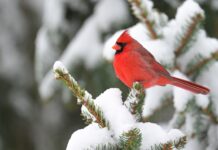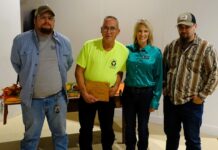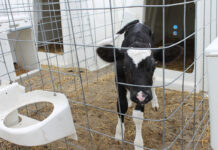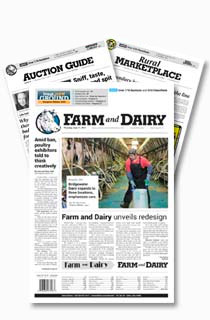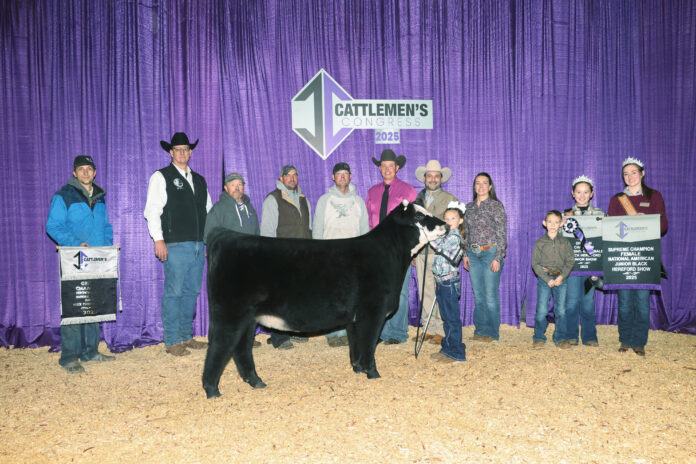
SALEM, Ohio — The Black Hereford, a relatively new breed of beef cattle, caught Jason Birney’s attention several years ago. He liked the combination of the Angus and Hereford cattle — two of the most popular and productive breeds in the United States.
So, the Harrison County, Ohio farmer decided to buy two Black Hereford heifers in 2018. Since then, his Black Hereford herd has grown to nearly 20 cows.
“My goal is to get them good enough to compete with any other breed,” Jason said. “We’re getting closer to that.”
The family has won national titles showing their farm-raised cattle, most recently taking top spots at the Cattlemen’s Congress, in Oklahoma. While Jason enjoys poring over the genetics and pedigrees, it’s also fun for the family to compete.
“The best part of showing is having fun,” said Nora, Jason’s almost 7-year-old daughter. “And I enjoy winning because all my hard work has paid off.”
Black Herefords
Black Herefords possess the docility, calving ease and feed efficiency of traditional red Herefords with the black hide of Angus cattle — a combination that’s beginning to grow in the cattle industry.
“What they’ve learned from feedlot studies is the Herefords are more docile, so their feed efficiency is much better than Angus,” American Black Hereford Association President Rod Garman said. “We’ve crossed these two breeds to get the marbled meat of the Angus and the docility of the Hereford. I just believe we have a great product with that cross.”
The Black Hereford traces its origins to the J&N Ranch in Leavenworth, Kansas where Hereford breeders began crossing Herefords with Angus cattle in 1994. The Black Hereford was developed by crossing registered Hereford and Angus cattle to produce an F1, then breeding those F1 females back to a registered Hereford bull and selecting for black hair color.
“I believe Angus and Herefords are the best breeds in the United States today,” Garman said. “If you take the best of those two breeds you get the best of both worlds,”
The American Black Hereford Association was established as a non-profit corporation in 1994, and the first Black Herefords to qualify for registration were recorded in 1997. The Black Hereford received international breed designation by the National Association of Animal Breeds in 2003, and two years later, the ABHA implemented its expected progeny differences (EPDs).
ABHA membership continues to grow. “Registrations are higher than ever — 2024 was a record year for us,” Garman said. “We have over 600 members.”
Because Black Herefords are a relatively new breed, less performance data is available than established breeds. However, the American Black Hereford Association continues to develop reliable EPDs to improve the breed’s market value and establish quality seedstock operations.
“It’s one of the smaller breeds,” Jason said. “But, it’s getting bigger and bigger, more people are registering.”
Junior shows
Jason and Vanessa have four children Rory, Nora, Finn and Lena. Rory, 8, and Nora show Black Herefords nationally.
The family farm is where the Birney children learn about livestock and how to care for their animals. Skyline Farms in Cadiz, Ohio is all Jason has known. He’s been farming his whole life. The Birneys are the third owners of the farm, first purchased by Roy and Eleanor Birney in 1959. Initially, they raised sheep and corn. Now, they raise beef cattle and hay on 4,000 acres.
“We work as a team, from breaking, washing and getting calves ready for a show,” Vanessa said.
Rory and Nora recently showed off their farm-raised calves at the North American International Livestock Exposition Junior Show in Louisville, Kentucky.
Black Herefords fall into several show categories. F1 is the half-Angus, half-Hereford category. F1s can be bred up with Hereford or Black Hereford genetics, however, they have to be 62.5% and up to be registered as a Black Hereford. The HX category is a red percentage or purebred, with 62.5% to 87.4% composing the red percentage and purebred being 87.5% and up.
The Birneys had four heifers there in various classes, and won each division in which they participated. Rory’s heifers were champions in F1 Female, Percentage Black Hereford Female and Supreme Female Percentage Black Hereford Champion. Nora’s heifer was named champion in the Purebred Black Hereford Female Show class.
The Birneys also competed at the Cattlemen’s Congress in Oklahoma City in January, where Nora’s percentage heifer won the Open Show title and was named Supreme Heifer.
She also won the Junior Show’s Reserve Champion Purebred Heifer and Champion Percentage Heifer classes. Rory had the Reserve Champion F1 Heifer and the Reserve Champion Percentage Heifer. Vanessa was successful in two Open Show classes. She had the Champion HX Heifer and the Reserve Champion Purebred Heifer.
The span between shows was an opportunity to tweak the cattle and make a few improvements.
“With the bigger shows, I like those shows spaced out,” Jason said. “If you need to fix something on the animals or kind of change them you have time for them to grow hair, you can change their shape a little bit or change your feed — it’s not hectic.”
Family support
This is Rory’s third year of showing and Nora’s first. Both children enjoy competing and value the effort they put into getting their cattle show ready.
Rory focuses on preparing the cattle for the showering. “The calves have to become familiar with me first, so we teach them to tie first, and then we begin to break to lead,” Rory said. “Every day I practice leading them and setting them up.”
When the kids get nervous they fall back on parental advice and a good attitude.
“My mom always tells me to be confident because I have practiced a lot to prepare for shows,” Rory said.
Nora added, “Sometimes I get nervous, but I remember to be strong and that I can achieve anything if I try.”
Vanessa’s advice comes from personal experience showing livestock. She’s been showing since she was young.
“I showed a variety of species while in 4-H, but my passion was and always has been horses,” Vanessa said. “When Jason and I started dating, he asked me to show a heifer for him in the Ohio BEST program, and of course, I said yes.”
In addition to helping Jason with cattle, Vanessa raises and shows Quarter horses.
“It’s similar to showing cattle, as it’s based on confirmation and conditioning,” she said. “Jason enjoys helping with the horses as much as I enjoy helping him with the cattle. We can support and bounce ideas off one another when breeding and fitting our animals.”


